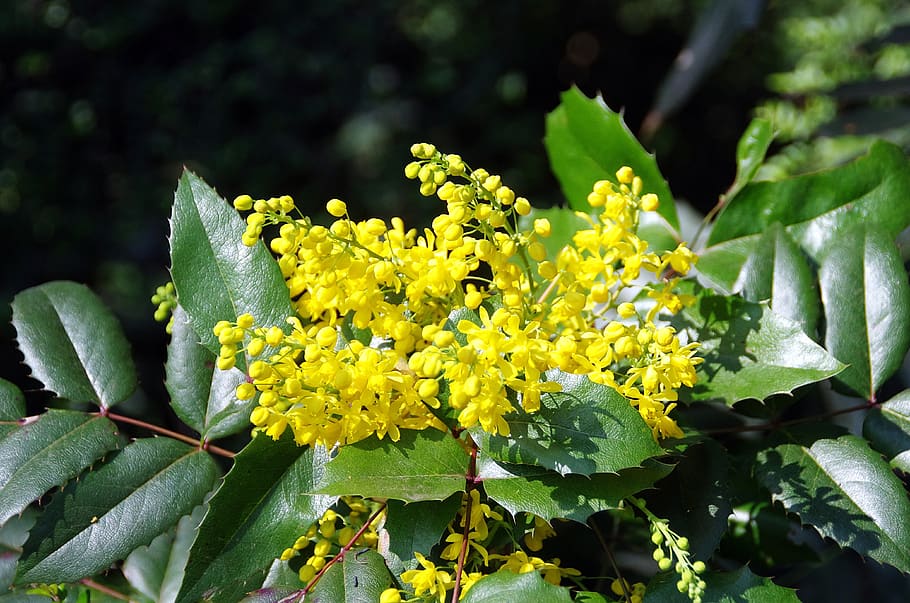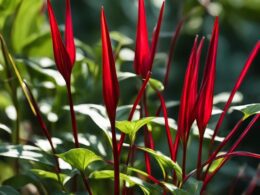Are you looking for an evergreen shrub that is not only beautiful but also easy to care for? Look no further than Mahonia Aquifolium!
This plant is known for its spiky leaves and vibrant yellow flowers that bloom in the winter. Not only is Mahonia Aquifolium an attractive addition to any garden, but it also has a number of benefits. Its leaves and roots contain medicinal properties that have been used for centuries to treat a variety of ailments. Plus, its dense foliage provides a safe haven for birds and small animals, adding to the overall sense of security in your outdoor space.
Keep reading to learn more about growing and caring for this wonderful plant.
Introduction to Mahonia Aquifolium
You’re about to discover a stunning plant that will add a touch of elegance to your garden with its sharp-edged foliage and vibrant blooms. Meet Mahonia Aquifolium, an evergreen shrub that is known for its spiky leaves and yellow flowers.
It’s a plant that is native to the Pacific Northwest and has been used for centuries for its medicinal properties. Mahonia Aquifolium, also known as Oregon Grape, is a popular plant that has many uses. It’s commonly used as an ornamental plant in gardens and landscapes due to its attractive foliage and colorful flowers.
The plant is also used in natural medicine for its antibacterial, anti-inflammatory, and liver-stimulant properties. It’s believed to be effective in treating a variety of ailments such as skin conditions, digestive issues, and infections. The history of Mahonia Aquifolium dates back to the indigenous people of the Pacific Northwest who used it for a variety of purposes.
They used the roots and bark of the plant to make a yellow dye for clothing and baskets. The plant was also used as a natural remedy for a variety of illnesses. Today, Mahonia Aquifolium continues to be a popular plant due to its beauty and versatility. It’s a plant that is sure to add charm and character to any garden or landscape.
Benefits of Growing Mahonia Aquifolium
If you’re looking for a low maintenance and hardy plant that will bring year-round interest to your garden, you should consider growing Mahonia Aquifolium.
Not only does it have spiky leaves and yellow flowers, but it also attracts pollinators like bees and butterflies.
With this plant, you can enjoy a beautiful and thriving garden without much effort.
Year-Round Interest
Keep your garden looking lively and vibrant all year long with a plant that offers both visual interest and colorful blooms. The Mahonia aquifolium is an excellent choice for garden design, as it provides year-round interest.
With its spiky evergreen leaves, this shrub adds texture and depth to your landscape architecture. Even in the winter months, the leaves remain green and glossy, providing a lush backdrop to other winter bloomers.
In the spring, the Mahonia aquifolium bursts into bloom with bright yellow flowers that attract pollinators such as bees and butterflies. The flowers give way to clusters of blue-black berries in the summer, which are a favorite of birds.
The Mahonia aquifolium is low maintenance and easy to grow, making it an excellent addition to any garden. With its year-round interest, this shrub is sure to delight and enhance the beauty of your outdoor space.
Low Maintenance and Hardy
Looking for an easy-to-care-for plant that can withstand the elements? The Mahonia aquifolium is a hardy choice that requires little maintenance and adds year-round interest to your garden.
This evergreen shrub has spiky, holly-like leaves that provide a unique texture to your landscape. In the spring, it produces bright yellow flowers that attract pollinators, and in the fall, it bears dark blue berries that provide food for birds.
One of the benefits of Mahonia aquifolium is its drought tolerance. Once established, this plant can survive long periods without water, making it a great choice for regions with dry summers or limited rainfall.
Additionally, pruning techniques can help shape the shrub and promote healthy growth. Prune in the late winter or early spring before new growth emerges, and remove any dead or damaged branches to improve the overall health of the plant.
With low maintenance and hardiness, the Mahonia aquifolium is a great addition to any garden.
Attracts Pollinators
You’ll be pleased to know that Mahonia aquifolium is a natural draw for pollinators in your garden. Its bright blooms provide a welcome source of nectar and pollen. This evergreen shrub is a great addition to any garden design. It attracts a wide variety of pollinators, such as bees, butterflies, and hummingbirds. By planting Mahonia aquifolium, you can help to increase pollinator diversity and support the health of your local ecosystem.
Not only is Mahonia aquifolium attractive to pollinators, but it’s also a low maintenance and hardy plant. It can tolerate a wide range of soil types and light conditions, making it a versatile choice for any garden. Plus, its spiky leaves provide year-round interest and texture.
So, if you’re looking for a beautiful, low maintenance shrub that will attract pollinators and add interest to your garden, Mahonia aquifolium is an excellent choice.
Growing and Caring for Mahonia Aquifolium
Growing and caring for Mahonia Aquifolium involves ensuring the soil is acidic and providing sufficient water. This evergreen shrub, commonly known as Oregon grape, thrives in well-draining soil with a pH level between 4.5 to 6.5. Adding organic matter such as peat moss or compost can help maintain the soil’s acidity level.
Moreover, Mahonia Aquifolium requires moderate watering; it’s essential to water it deeply once a week and keep the soil moist but not waterlogged. Pruning techniques and soil requirements are essential factors in growing and caring for Mahonia Aquifolium.
Pruning should be done in late winter or early spring before new growth appears. Trimming back long or damaged branches and removing the older, lower branches can help promote growth and maintain its shape. Additionally, fertilizing once a year with an acid-loving plant food can help ensure its health and vigor.
Mahonia Aquifolium is a versatile shrub that can thrive in various growing conditions. However, it’s essential to plant it in a spot that receives partial to full shade, especially during hot summer months. Moreover, it’s a low maintenance shrub that is relatively easy to care for.
By providing acidic soil, moderate watering, and occasional pruning, you can enjoy its beautiful spiky leaves and yellow flowers throughout the year.
Common Uses for Mahonia Aquifolium
If you’re looking to add a touch of natural beauty to your landscape, Mahonia Aquifolium is an excellent choice. It offers a range of practical uses beyond just its aesthetic appeal.
One of the most notable uses of this evergreen shrub is its medicinal properties. The plant’s roots, bark, and leaves contain a compound called berberine, which has been shown to have anti-inflammatory, antibacterial, and anti-cancer properties. It’s commonly used to treat skin conditions such as psoriasis and eczema, as well as digestive issues like diarrhea and irritable bowel syndrome.
In addition to its medicinal properties, Mahonia Aquifolium is a popular choice for landscaping due to its spiky leaves and yellow flowers. It’s commonly used as a hedge or border plant, as it can create a natural barrier thanks to its thorny leaves. Its low maintenance requirements also make it a popular choice for those looking to add greenery to their yard without spending too much time on upkeep.
Overall, Mahonia Aquifolium should be on your radar if you’re looking for a versatile and practical addition to your landscape. Whether you’re looking to harness its medicinal properties or simply add some natural beauty to your yard, this evergreen shrub is sure to impress. So why not consider adding it to your garden today?
Would Red Leaf Plants and Yellow Flowering Shrubs Be Suitable for a Garden Together?
If you want to create a vibrant and visually appealing garden, consider pairing red leaf plants with yellow flowering shrubs. The contrasting colors will create a striking effect. To identify red leaf plant ease, look for varieties like red-leaf Japanese maple or red-leaf barberry, which are perfect for this combination.
Conclusion and Final Thoughts
As you close out this article, take a moment to envision the unique and practical addition that Mahonia Aquifolium could bring to your garden or landscape. This versatile evergreen can be used as a focal point or as a filler plant in a variety of settings. Its spiky leaves and yellow flowers add a bold pop of color and texture to any space.
When it comes to gardening tips, Mahonia Aquifolium is a low-maintenance shrub that can thrive in a variety of conditions. It prefers partial shade and well-drained soil, but can tolerate full sun and even some drought once established. This shrub is a great choice for beginner gardeners or those looking for a low-maintenance addition to their landscape.
For landscaping ideas, consider pairing Mahonia Aquifolium with other evergreens or using it as a backdrop for colorful perennials. Its bright yellow flowers make it a great choice for adding interest to a winter garden or for creating a focal point in a spring or summer landscape. With its unique combination of spiky leaves and striking blooms, Mahonia Aquifolium is sure to make a statement in any garden or landscape.
Frequently Asked Questions
What other plants are commonly grown alongside Mahonia Aquifolium?
Companion planting with Mahonia Aquifolium is an excellent way to create a natural habitat in your yard. This evergreen shrub not only adds beauty to your landscaping ideas with its spiky leaves and yellow flowers, but it also provides numerous benefits when grown alongside other plants.
The benefits of growing Mahonia Aquifolium with other plants include increased biodiversity, reduced soil erosion, and increased pollination. Additionally, companion planting can help deter pests and diseases, reducing the need for harmful chemicals.
By choosing the right plants to grow alongside Mahonia Aquifolium, you can create a thriving ecosystem that supports a variety of wildlife and promotes a healthy environment.
What other plants are commonly grown alongside Mahonia Aquifolium?
How long does it take for Mahonia Aquifolium to grow to full maturity?
Looking to add some evergreen shrubs to your landscaping? Mahonia aquifolium might be just what you need. It’s a slow-growing shrub that can take up to 10 years to reach full maturity, but it’s worth the wait.
Not only does it add visual interest with its spiky leaves and yellow flowers, but it also has skincare benefits. Mahonia aquifolium contains berberine, which has anti-inflammatory and antibacterial properties that can help with acne and other skin conditions.
If you’re looking for other varieties of evergreen shrubs for your landscaping, consider boxwood, holly, or juniper. These shrubs are versatile and can be shaped into different sizes and shapes to fit your design needs.
Can Mahonia Aquifolium be grown in containers or does it require a specific soil type?
If you’re looking to grow mahonia aquifolium in containers, it’s important to choose the right soil type. This evergreen shrub prefers well-draining soil that is rich in organic matter. You can use a mixture of potting soil, sand, and perlite to create the perfect growing environment.
Container gardening is a great option for those who have limited space or want to move their plants around. Just make sure to choose a container that is large enough to accommodate the plant’s root system and has drainage holes to prevent waterlogging.
With the right soil requirements and container, you can successfully grow mahonia aquifolium in your home garden.
Are there any pests or diseases that commonly affect Mahonia Aquifolium?
Mahonia aquifolium, also known as Oregon grape, is a popular choice for landscaping and garden design due to its evergreen nature, spiky leaves, and bright yellow flowers. However, like any plant, it’s susceptible to pests and diseases.
Common pests that may affect mahonia aquifolium include aphids, spider mites, and scale insects, while common diseases include leaf spot and powdery mildew. To prevent and treat these issues, it’s important to keep the plant healthy by avoiding overwatering, providing adequate sunlight, and pruning damaged or diseased branches.
Using insecticidal soap or neem oil can help control pests. Despite the potential for pests and diseases, mahonia aquifolium is a valuable addition to any garden or landscape due to its beauty and versatility.
Is it possible to propagate Mahonia Aquifolium through cuttings or division?
If you’re looking to propagate Mahonia aquifolium, you have two main options: cuttings or division. Cuttings are a great way to create new plants that are genetically identical to the parent plant. To do this, take a cutting of the plant in the early summer and remove all but the top 2-3 leaves. Dip the cut end in rooting hormone and plant it in a well-draining potting mix. Keep the soil moist and in a bright, but not direct, sunlight.
Division is another option, but it’s best done in the fall or early spring. Simply dig up the parent plant and divide it into smaller sections, making sure each section has roots and at least one stem. The growth rate of Mahonia aquifolium is slow to moderate, but with proper care, the plant can establish quickly.
Conclusion
You’ve learned all about Mahonia Aquifolium, the evergreen shrub with spiky leaves and yellow flowers. Growing and caring for this plant can be a great addition to your garden, as it offers numerous benefits such as attracting pollinators and providing medicinal properties. Plus, it’s a low-maintenance plant that can thrive in various soil types and light conditions.
In addition to its practical uses, Mahonia Aquifolium is also a beautiful addition to any landscape. Its bright yellow flowers and deep green foliage make it a standout in any garden. Whether you’re looking to add some color to your yard or reap the medicinal benefits, Mahonia Aquifolium is a great plant to consider.
So go ahead and give it a try, you won’t be disappointed!









